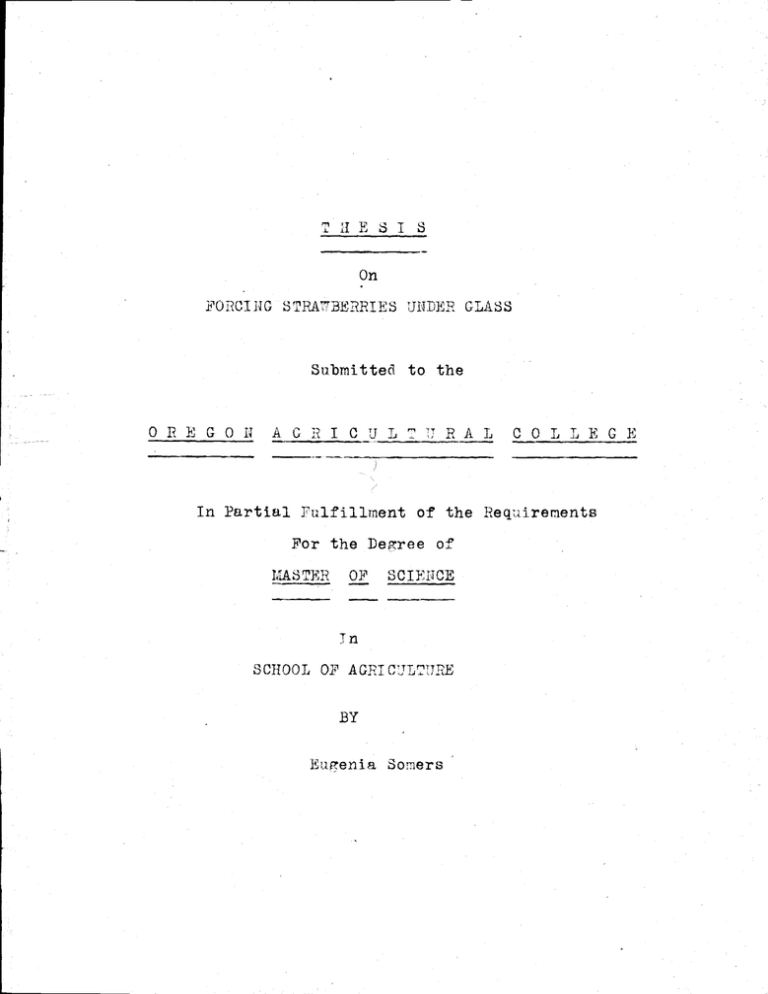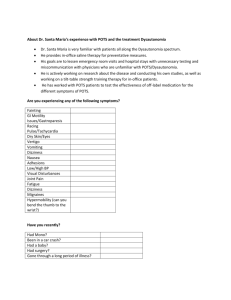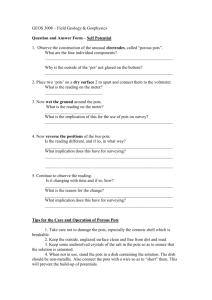OREGON AGRICULTURAL COLLEGE
advertisement

-, I t £ On iORCI NG 3TRAT BERRIES UNDER GLASS Subnitte to the OREGON AGRICULTURAL COLLEGE In Partial Fulfillment of the Requirements For the Degree of MASTER O SCIENCE in SCHOOL OF AGRICULTURE Eucenia Somers APPIOVED Redacted for privacy Professor of eTn charge of Major Redacted for privacy Head of Department of - Redacted for privacy Dean of School of Chairman, Comnittee on Graduate Students and Advanced Deprees ILl TRODTJ C TIOLl For a number of years, considerable interest in strawberries as a greenhouse crop ha b been manifested florists and others who produced out of season crops. During the latter part of the nineteenth century several articles appeared in the agricultural journals upon this subject. Most of them, however, were vague and contain- ed little information as to methods of culture. In 1897 Cornell University published a bulletin entitled "Strawberries Under Glass." This described the cultural methods used. in the greenhouses at that station. In 1905 another bulletin was issued by Cor- nell on "Forcing of Strawberries," which discusses the varieties best adapted for forcing. It describes an experiment in which one hundred thirteen varieties were tried out :ln the roerxhouse. Of these varieties but three, the Marshall, Glen :iary, and President, were found to be satisfactory for forcinc under glass. This bulletin also discusses econorry in handling plants, optimum temperature during forcing period, length of tine required to mature a crop of strawberries, and the control of the red spider. After the publication of the søoid Cornell bulletin very little appeared In print regarding Strawberry Porcine until 1917 when a bulletin was issued by the Colorado Experiment Station. This described an experi- meht in which nine varieties were tried out, of these, two, the Marshall and Glen Mary were recommended as satisfactory. and yoin The relative merits of year old plants plants were inve;iated. were found to The yo1nn plants produce a heavier yi1d and larger berries. Cultural methods and fertilizers were also discussed bat no check plots were mentioned and apparent- ly all plants received the same treatment and were given the same kinds and amounts of fertilizers. The main experiment seemed to be that of testing out varieties. OBJECT OF PRESENT EERIUiT As Strawberry or cing had not been tried on the Pacific coast and as it offered possibilities as a profitable greenhouse crop an experiment was planned in the fall of 1919, the objects fwh:ich were--- 1. To determine which varieties of those commonly grown in Oregon were best adapted for forcing. 2. To investiate the possibilities of modifying cultural methods commonly used in Eastern States without interfering with the success of the crop. 3. To determine the response of 'the different varieties to a'pn1icatios of nitrate of soda. 4. ages. o compare the yield of plants of different METHODS AND MATERIALS Methods com practiced in Eastern States and in Colorado in forcing Strawberries. At Cornell Experiment Station and at the Colorado Exeriment Station plants for forcing were obtained in the followirw manner:- Small pots filled with rich soil were pluned along rows of virgin plants, that is, plants which had. never borne a crop of fruit. Runners from these plants were led over the pots and fastened there until they had taken root. ed. Only the first and strongest runners were selectAfter they were well rooted taken to a er pots. potting shed where the pots were lifted and they were shifted into larg- In the first Cornell experiment several shifts were rade, but in the second experiment the plants were shifted directly into fruitin potS. At the Colorado Station the runners were rooted in five inch rots and allowed to remain in these until Auust when they were lifted from the bed, shifted into seven inch pots, and plunced into sand in the cold frame. At Cornell the plants were also plunged into a cold frame in coal cinders. They were watered well once, then Lowed to become dry. Later they were watered as needec7 il the roots filled the iots, when water was again h held to encorage t.e formatiofl of a large crown. The plants were left in the cold frames until January when they were gradually thawed out and moved into the The temperature was increased until at greenhouse. blossoming time it was about 65 degrees F. During pollenation and ripening the temperature was kept at' 70 degrees P. The conclusions drawn by those in charge of the experiments was that: 1. The Marshall, Glen Mary, and President were the best varieties for forcing. 2. A resting period of about three months was necessary. 3. A slow starting of the plants ormittod a stronger development of the root svstem. 4. New crowns were preferable to old ones as they roduce a heavier yield and larger and better berries. METHODS USED IN PEESENT EXPEETMENT As the experiments at Cornell and at the Colorado Experiment Stations were conducted with potted plants the preparation of which involved considerable time and expense, it seemed desirable to devise sore methods which would eliminate the pots and the preliminary handling of the plants. As this experiment was not planned until late in September no potted plants which had been in the field could be obtained as checks. rooted in pots Young sets were purchased from the nurser: and were potted in slx inch pots November 10th 1919. frames until January 1st. 1020. They were kept in cold In conducting the ex- perirrient these were regarded as checks. To discover the possibility of reducing the expense of early handlimr of the plants four varieties of straw- berries were lifted in the field, January 1st 190 and brought directly into the greenhouse. ost of these were planted in the bed, being set one foot apart each way. o test their yield in pots eleven Oregon plants and five Progressives were planted in six inch pots. Every care was used in handling these to avoid injurin the roots or in any way disturbl rig the ballcdf earth siirroundng them. At this time the potted plants in the cold frares were moved into the greenhouse and the check pots were placed on a shelf directl:T above the heating pipes. Others that had received the same previous treatment were removed from the pots and set in the bed for comparison with those in the pots. Six months old plants were found to be "best in New York, but it seemed reasonable yearling plants which would normally bear their first o:'op the following season, would prove nrofitable when forced. Such plants wee brought in January let. 1920 and at the same time well grown sets were lifted and brought in for comparison. To determine the response of the iferert varieties of strawberry to nitrogen the viants in each variety vere divided into two parts, one of which recei'ed. nitrogen while the other did not. LATERIALS JS.LD I i EXJ?IENT The varieties of strawberries which are successful comrercially east of the Rocky Mts, have not proveô profitable on the Pacific Coast, therefore new varieties have sprunw up which, while productive in the Western states, are not satisfactory in the eastern part of the co'intry. In planning this experiment it was first intended to compare varieties which were recommended for forcing in the east with local varieties which, while known to be snccessfu.l in the field, had never been triec out in the greenhouse. However, obtaining good healthy o lints of the eastern va'ieties proved to be difficult. Fifty Marshall plants were purchased from the nursery but they arrived in such povr condition that they could not he used. Five plants were pthted and used as checks, the rest were excluded from the exDeriment. It was then decided to use only western varieties arid to coiipare them wIth each other as to which most nearly aDproached the ideal forcing berry of the east as well as which was best adapted to local forcing corn are conditions. In order to/the forcing possibilities of n varieties the characteristics of the vanen are described below VARIETI3 CHOSEII Oregon or Admiral Dewey Strawberry originated near It is a cross Salem, Oregon, with Mr. A.F. Hofstadtler. between the Marshall and Jessie and is perfect flowering and medium to early as to season. The Fruit is variable as to size and of good qal1ty but a poor keeper. Magoon orinated as a chance seedlin of V.J. Magoon near large and vigorous. medium earl;. Portland, in the garden The plant is very Oregon. The flowers are perfeot and open The fruit is variable in shape and size but usually is quite large, flesh is dark red and rather soft. Marshall is an eastern variety which has proved succesaf all as a forcing crop but not suocessfall as a field In Oreon it has proved satisfactory in a few local- cr01). itles. It is a mid season, soft, but productive variety. Proressive originated in Oregon and belongs to the ever beaTing type of strawberry. continuously during the In the field it bears late sumrer and fall. It would Jnder greenhouse be termed a very late season variety. cOnditions, it produced a number of blossoms during Jan- uary, but the stamens did not mature and as no pollen was time, obtainable from other sources, at that The main crop did not materialize until no frujts set. too late to be of value as a Porcing variety. Gold lollar originated at 3pringbroo), Oregon. plant is large, erect, and vigorous. The The crop inthe field is early, but below medium in yeild. in size and conical in shane. The fruit is medium This is the best early field crop for Oregon. Wilson originated near Albany, N.Y. many vears ao and was very popular for over twenty years. It is a pioneer variety, growing best on soil that have not long been under cultivation. The plant is medium in size, viror, and yield. The quality is below medium. It is a good canning berry. Superb is an overbearing variety which is a poor plant ma3er. yelids well but Ettersburg 121 was originated by A.P. Etter, Briceland California. It is a "hybird of the wild Alpine crossed with the Cape Mendocino Beach strawberry." The plant is large and very prodnictive but the fruit is below medium in size although of good quality. This variety produces better on dry soils than it does on the more moists and fertile sthils as in the latter case it produces only foliage and new plants. DETAILED DI SCiJSSION OF EXPERIll1iT The six months old plants which were ordered. from the nursery arrived flovember 10, 1919 and were potted immediately. The Gold Dollar plants were large and vigoro;s with good root systems. Twenty three of them were potted of which sixteen were later selected for forcing in the greenhouse. The Superb plants were not so vigorous as the Gold Dollar but thirty were iotted,. The root systems were good but the leaves were black- ened and moldy and there were blossoms or fruit on most of the plants. The Clark's Seedlin's and arshal1s were so sal1 that they were not potted but were placed in flats until they began to .row. 1ive of the larger Clark's Seedlings were pott- ed. and treated like the other varieties but were not considered as rart of the experiment. All of the rlants which were potted November lOtli, 1919 were placed in the cold frame until anury 1st, 1920 when they were moved Into the greenhouse. While in the cold frames they receLved little care except that they were watered Occasionally. During 'december the cold frames were buried under the snow, which protected the plants during the zero weather. Fifteen of the 3uperbs were removed from the pots and set in the bed; the other fifteen were left In the pots and wore placed on the sill piats of the reenhose just above theheating pipes. The six pots of IJarsha1l plate. Five Clark Seed.lins were also potted and set in the same place. wore also et on the s:il1 The Cold Dollar plants were removed from the rots and set in the bed. December 30, 1919 Mnroon plants were broNghi in from the field. and set in beds. These were lifted with a large ball of earth around their roots and every care was taken to prevent disturbing the roots in any way. Owing to the previous cold weather which had killed most of the fo1i.e the ae of the ants was difficult to ascertain but thirty plants were selected which seemed to be yearlings and nine runners were also brought in. Of these, six were quite 1are and had apparent - ly rooted early in the season while three were sia1l. The following day Oregon and Progressive plants were obtained from the farm of Mr. Ed. Felton,as with the Maoons the age of the Oregons was not easy to determine but fifteen plants were selected which had larger root systems than the others and were probably yearlings. runners were brought in at the same time. Twenty-five They were large and seemed to have been rooted early in the season. fifteen yearling plants and fifteen set in the bed. The tbe runners were Eleven runners were potted and set on the sll pinte. Pour yearling Progressive plants were set in the bed. These had very large crowns and well developed root systems. Twenty-four runners were also set in the bed. They were quite small and the soil had been washed from their roots. Two runners were obtained which had been lifted with a lare ball of earth around their roots; in the bed. these were placed Five young plants were potted and set on the sill pate. Six yearling plants of the Ettorsburg 121 variety were lifted in the field and brought into the greenhouse Decerber 23, 1919. They were very large and vigoro'is. On January 1, 1920 fourteen young pants of this variety were planted in the bed. Mr. Polton had obtained these plants from a nursery during the fall and had "healed them in" until time to plant them. They had no soil on their roots when planted in the bed in the greenhouse. Al. ter all of the Oregon plants had been planted as planned for the experiment a number of good plants were They had been dug with left. a spade arid were rooted in blocks of earth about one foot in diameter. At first sight each block appeared to be one large plant bt;t upon investigation proved to consist of from three to five Five such blocks of earth with their plants young plants. were set in the bed without disturbing the roots of the plants. These were to be compared with the young Oregon plants which were planted one foot apart each way. TIATMENT OF PLJiT$ R11 EXPERIMHT During the first two weeks after the plants were plac- ed in the greenhouse the temperature was kept between 55 degrees and 60 degrees F. After January 16, the temperature was raised to 60 degrees F. Between February 1st. and April 1st it was kert between 65 and 70 degrees F. and after that time at 75 derees F. The first application, of nitrate was given January 25th, after that date applications were given twice each week until Larch 6th. Then no more was applied until April 7th. when one application was given. the time the Io more was anpiled during experiment was being conducted. In all about 12T0 grans of nitrate of soda were used during the forcing period. The plants were given all of the water they required except at blooming time when water was withheld. somewhat to a:id in pollenation. None of the varieties except the Ettersburg 121 showed any tendency to produce runners. The young Ettersburg 121 plants produced many runners and very little fruit, only a few of these runners were removed. The yearling Ettersburg 121 produced a few runners which were cit off at once. RE $TJLT S Observations on Progress of Plants. On January 17, 1920 foliage had begun to grow on all varieties except the iCagoons. Ettersburg 121 and the Suerb. It was most abundant on the By January 30th the Etters- burg 121 was showing a tendency to produce runners. was starting to grow n the Macoons. Foliage An Oregon plant had one bud and the yearling, Progressives were full of buds, none of which set fruit owing to absence of pollen. On February 5, a blossorr appeared on a Gold Dollar plant, the next dar there were blossoms on the year1in the Wilsons and the Oregons . Progressives, Pebruary lth the first bloss- om producing pollen was found; up to that date only pistillate flowers had appeared. A weo1 later pollen was abund- ant among the Oregons altho a few pistillate flowers were still in evidence. The blossons of the New Oregon, the Ma- goou, the Gold Dollar arid the Wilson were large but those of the Progressive were small and soon fell off. Three of the potted Oreons were in bloom on February 24th as were also those which had been set in clumps. March 2nd the Oregon and Magoon were in full bloom. One Gold Dollar plant had several fruits set and another had two fruits; the rest of the plants of that variety showed no sins of blossoming. At that tthe nitrate of soda apDeared to have little effect upon any of the plants. The writer became ill March 6th and was unable to care for the plants until Arril 5, 1920. plants were During this time the watered and pollenated by Mr. A. E. Murneek. On April 5th the writer found that much fruit was set on the Maoons and Oregons. fruits. The Oregon pots had ten ripe The Gold Dollars had five and a few blossoms, as did also the Superbs and Progressives. April 16th. there were iany ripe fruits on the Oregons and a few on the Magoons and Gold Dollars. On this date photographs were tal<en of the Oregons in pots, also of the Superbs and Progressives. The nitrate pots had more foliage and smaller berries or none at all. May 4th and 5th experi!,ent was closed and the number of blossoms and berries were counted. The Oregons kad near - ly finished bearing but the Maroons had many green fruits which were nearly full grown. The Ettersburgs were just beginning to ripen while the Progressives and Superbs were white with flowers and buds. A much larger yield might have b'en obtained if the experiment could have ran longer bt the later maturing varieties would not have ripened until the earlier varieties growing in the open were placed on the market. A greenhouse crop, that matures so late in the season, would not be profitable, anyway. The experiment was closed in order that the data might be tabulated for the thesis, COLLEOTIOfl OF DATA During the ripening period all ripe berries were picked and weighed immediately. ed in grams. The weights were record- All the plants were numbered and the product- ion of each was recorded separately in what percentage of the plants order to discover failed to set fruit, as wel'. as to observe any tendencies toward unusually high production in any partiôular plant. Table 1, Giving Comparison of Varieties as to total Production Average Average Average No. Averae weicht weight green fruits No. of ripe fru.its of Variety per plant per plant ripe fruit each rer plant fruit Magoon 6.41 5.53 23.16 4.17 Oregoris 2.73 7.96 4o.52 5.93 pots 1.55 Ettersburg 21.50 Prog. bed 0.96 Prog. pots 1.33 9.45 41.42 4.28 5.75 16.36 2.84 1.33 3.10 2.33 2.66 9.31 3.4 SuDerb (1) .94 .88 1.91 2.17 Superb (p) G. Dollar .41 1.12 2.54 2.16 .20 1.80 6.42 3.56 Wilson 1.35 2.43 5.03 2.0? iarsha1l 1.50 .83 3.51 4.22 The Oregons produced the highest yield and the largest berries. The Maoon ranked second as to yield bit was about one week later in ripening so that only about half the fruit had matured when the experiment was closed. The yearling Ettersburg 121 set a heavy crop but were rather late for a forcing crop and the berries too small to e1l for the fancy prices that greenhouse crops must demand in order to be profitable. The Progressive and Superb are likewise too late in fruiting to inake a rood forcing crop. To be ideal, a variety mast produce a large, uniform1r maturing crop of bright colored berries of uniform size and shape. The Oregon most nearly approaches this ideal bat does not have as attractive a flavor as does the Magoon. The berries of the Oregon are uniformly colored and attractive in appearance,. as they ripen quite evenly and would be suitable to grow in pots for banquets. Table 11, Modifying Cultural Methods Xeeping plants in pots during fruiting period versus planting them in beds at the beginning of the forcing period. Average weight Average per plant Variety Pipe Fruits of each fruit mt.ripe frnit Pots 7.96 9.45 46.52 41.52 Oregon Progressive 1.12 2.66 2.68 9.31 1.91 2.54 .88 1.12 Superb Totals 9.96 13.23 51.11 53.37 l7.034 17.79 Pots Bed Average 3.32 4.41 The plants in pots were smaller except in Bed Bed Pots 5.93 10.49 4.28 3.49 2.16 9.93 3.49 3.31 2.39 2.17 yielded heavier but the berries the case of the Progressives. Probably the results of the Progressives would have been reversed if the experiment had not been closed so soon for the plants in the beds were full of blossoms when the experiment closed. The fruit in because the pots were set on heatin did the pots ripened earlier the siliplate just above the pines and the temperature averages higher than over the bed. plants in pots it Considering the expense of handling the the increased yield justify the practice. i8 not sufficient to Table 111, The Production Der square foot of space of plants set one foot apart each way versus plants set in elmps of three to eight plants as dug with spade. Each clump occupied two sq. feet of s'pace ripe fruits wt. of ripe fruit wt. per fruit Plants set one foot apart each war 7.87 40.13 5.10 Clumps of plants average per sq. ft. 11.20 53.75 4.78 Average producti on of each plant in clumps. 4.48 21.42 4.78 Wbile the average size of the berries is somewhat lower the average production of the clumps per square foot of space is sufficiently high to warrant farther experimenting along this line. ab1e lv, Influence of nitrate of soda upon the production of the different varieties as to number of fruits and uniformity of ripening. Average # green fruits per plant Jntreated Nitrate Var'letv Average 7 ripe ftuit per plant 7ntreated Nitrate 11.80 3.20 6.20 6.33 4.00 1.87 8.07 7.87 .40 2.50 11.20 8.00 61.66 79.66 16.66 20.33 .58 1.66 1.50 1.00 rro,, (nots) 1.00 1.66 2.66 .66 Superb (bed) .63 1.50 1.00 .66 Superb (pots) .36 .50 1.54 .33 Gold Do11ar .00 .50 2.11 1.33 Totals 80.43 93.05 50.94 48.51 8.94 10.34 5.66 Magoon Oregon (bed) Oregon (Dots) Ettorsburg Prog. (bed) Average 5T The untreated plants produced fewer berries. They ripened their crop in the pots somewhat earlier but in the beds the treated plants ripened their crop first. Eliminating the Ettersburg 121 plants, the other eight varieties show an average yield of 5.89 berries for the untreated plots and 4.60 berries for the nitrate plots. Influence of nitrate of soda upon the Table V, production of each variety and upon the average weight of the individual fruits. Average weight of ripe fruit per plant Tlntreated Nitrate Variety Average weight of each strawberry untreated Nitrate 26.93 23.33 4.34 3.80 Oregon(bed)52.8'7 40.13 6.55 5.10 0re.(pots)54.52 30.50 4.86 3.81 Ettersburg 37.63 66.56 2.64 3.27 4.13 1.97 2.75 1.97 Prog. (notb)8.33 10.30 3.12 3.86 Super(bed) 2.02 1.73 2.09 2.60 Superb(pots)3.33 .76 2.15 2.30 Cold Dollar 8.19 3.76 4.33 otal 198.02 178.04 32.83 29.54 19.78 3.65 3.18 Magoon Pro.(bed) Average 22.00 The production was greater for the untreated than for the treated plants and the berries were larger. It was noticed however that the Oregons in nots which had received nitrates wore setting a new cro o- berries vhen the oxperient closed. The untreated pots showed no sL'ns of producing any more berries. Only the Etersburg showed any rn mar1ed increase In production due to nitrates. The Progressives and. Supèrbsshow a slihtincrease in the size of th berries where nitrate was applied. Influence of age of plants upon Table Vi, production. Average wt. er fruit Average ripe fr7its Wt. of ripe fruits Yearling Young Yearling Young Yearling Young Variety Llagoon 6.26 4.50 25.30 23.01 Oregon 8.07 7.87 52.89 40.13 Ettersbrgi8.5O .28 D2.lO 1.35 3.39 ProRressive .25 Total 33.08 Average 1.25 14.15 131.52 8.27 1.50 3.54 32.88 4.03 5.32 6.55 5.10 2.82 3.65 5.00 2.26 68.78 18.40 17.19 lc.33 4.60 4.08 The production of the yerin plants of the Ettersburg 121 and 0reon was greater tiian that of the young plants of the same variety. The average production of all four varieties was also greater for the yearling plants. The results seem to show that yearling plants are very much more profitable than young plants even raising them to their second season is considered. The luzuriant foliage of when the additional expense of the yearling Oreons caused some of the fruit to rot while green. This rotting also occured among the young plants of this variety but to a srnalter rotting occured among the the potted Ore ens. extent. No other varieties nor among STJMIARY 1. The results of this experiment seem to show that strawberries can be forced successfully under Western Oregon conditions. fruit of any During the early spring months fresh kind is scarce and commands a fancy price. Placing strawberries on the market at this time would be opportune and little trouble should be experienced in creating a demand for the crop. 2. Some varieties of strawberries which have originate in Vestern Oregon, Washington and California lend themselves well to Threing under glass. 3. The Ettersburg 121, the Progressive and the Superb are late season varieties and, when forced, are too slow in producing a crop to be profitable. The first named variety would set a heavy crop which might offset the increased cost of forcing if the berries were of good size. Owing to the humid conditions in the greenhouse the tendency of Ettersbu.rg 121 is to produce luxuriant foliage and the berries, while numerous, are too small to be attractive. 4. Of all the varieties tried out the Oregon is the most promising as a forcing variety. It produced more berries and larger berries than any other variety and the crop ripened uniformly so that it could be marketed advantageously. The berries are bright red and evenly color- ed with no white tips. They are attractive in ai'pearance whether displayed in boxes or on the potted plants. In the latter case they shouid sell well for banquets as the large red berries and luxuriant creen foliage are very striking. 5. Except when raising potted plants for banquets, the slight increase in yield from the potted plants would not justify the expense of handlin the plants in pots. 6. The application of nitrate of soda did not in- crease the yield sufficiently to offset the expense of the nitrate and the labor of apilying it. 7. In the case of the Ettersburg 121 and the Oregon the production of the yearl1n plants was enough greater than that of the young plants to offset the expense of raising the plants to that age before forcing them. 8. The data seems to show that large plants bro;ght from the field with their roots undisturbed are better for forcing but more investigation is needed along this line. ACKNOWLEDGL:ENTS The writer wishes to express her appreciation for assistance and suggestions given her by members of the faculty in p1annin and conducting this experiment. Professor W.S. Broin helped plan the experiment and. arranged for space in the greenhouse and cold frames. ir. William A. Smart helped secure the plants and Mr. A. E. Murneok earect for them during the writes illness. Dr. E.. iiirvey offered many valuable suestions and to use permitted the vriter/space in the research laboratory for investiiation of the hstolocical phases of the problem and the use of scales in the laboratory while collectinp the data. LITERATURE CITED Vallea, W.D. "Sterility in the Strawberry." Journal of Aprioaltiiral esearch. Volumn Xli No. 10 (1918) Gardner, V.R. "Strawberry Varieties in Oregon." Second Bieja1 pp 50 to 94. roi Pest and Horticultural Report (115) 0.A.C. Experiment Station. E t t e r, ibert P. terbtrg Strawberries." 1917 catalog )"Strawberries Under Glass." Hnnn Bailey Cornell Experiment Station bulletin No. 134 (1897) Hunn C.E. "Porcing of Strawberries" Cornell Experi- ment Station bulletin No. 231, 1905. Kinnison F.I. "Strawberry Foriong" Colorado RxDeriment Station bulletin No. 222 (1917) EXPLANATION OP PLATES Plate 1. no nitrate. ripe. Three of the potted Oregons which received The berries are large and many of them are There are no blossoms left on April 16, 1920 when the photo was taken. Plate 2. Three potted Oregons which received nitrate during forcing period. ripe. The fruit is not large and. few berries are The plants are still blossoming. Photo was taken April 16, 1920. Plate 3. Two Progressive plants one of which received nit- rate and the other was untreated. while the former did not. The latter produced berries These were photographed the same day as the Oregons, and. illustrate the difference between varieties quite well. Plate 4. Two Superb plants one of which received nitrate while the other dId. not. the others were. Photo taken the same day that --: 0 Plate 1. Plate 2. Plate 3. Plate 4.




